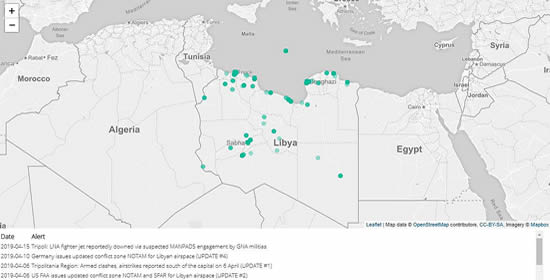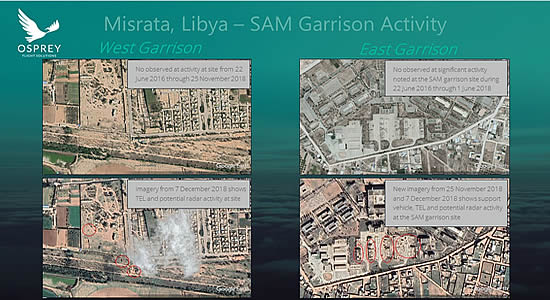Libya: Helping operators navigate a challenging regulatory and security environment
The conflict in Libya highlights one of the most significant challenges facing aviation operators in the current climate.
Following the escalation in military air activity in the country since the start of April, the US and German aviation authorities have both issued updated advice to their respective operators prohibiting flights in different but overlapping specified geographic areas within FIR Tripoli (HLLL), but allowing flights to continue in the remainder of FIR Tripoli above FL300 and FL260 respectively.
This followed an easing of restrictions by the US FAA on 19 March, prior to which all operations over, into or out of Libya were prohibited.
However, throughout the same period of time, the European Union Aviation Safety Agency (EASA) along with the UK and French civil aviation authorities have continued to advise civil aviation operators to defer all forms of flight operations within FIR Tripoli (HLLL) or to airports in Libya due to the enduring conflict zone environment.
We do not assess the factions in Libya will reach a peaceful reconciliation within the next six months.
On 9 April, Germany issued an updated notice for Libyan airspace (FIR Tripoli (HLLL)), which now prohibits German operators from conducting flights in areas north of 31° N latitude and west of 16° E longitude over the country, due to the ongoing military conflict in Libya (EDGG B0278/19). Previously, on 6 April the US FAA also issued an updated notice and Special Federal Aviation Regulation (SFAR) for Libyan airspace (FIR Tripoli (HLLL)), which prohibits US operators from conducting flights in areas north of 29° N latitude and west of 17° E longitude over the country, due to the ongoing conflict (SFAR 112, KICZ A0012/19).
The updated NOTAMs allow German and US operators to continue to conduct overflight of the remainder of Libya (i.e. airspace not located within the geographic areas outlined above) at altitudes above FL260 and FL300, respectively. The FAA had only recently eased its restrictions on overflight of Libya on 19 March, having previously prohibited US operators from conducting all forms of flights over FIR Tripoli (HLLL) at any altitude and all operations to airports in Libya. This followed a period of de-escalation in the country, with a significant reduction in conflict-type activity over the previous 12 months, as shown in the figure below.
Significant reduction in conflict-type activity over 12-month period. Image taken from Osprey:Explore

However, throughout the same period of time, the European Union Aviation Safety Agency (EASA) along with the UK and French civil aviation authorities have continued to advise civil aviation operators to defer all forms of flight operations within FIR Tripoli (HLLL) or to airports in Libya due to the enduring conflict zone environment (NOTAM EGTT V0003/19, AIC France A 03/19, EASA CZIB-2017-02R3).
On 4 April, the Libyan National Army (LNA) commenced military operations in the Tripolitania Region, located in the west of the country, with the stated intent of taking control of the capital Tripoli from the UN-recognised governing body, the Government of National Accord (GNA). The LNA is aligned with the House of Representatives (HoR) governing body based in the eastern city of Tobruk. The HoR is a rival to the GNA, which is based in Tripoli and has aligned militia forces controlling the city of Misratah. Both the LNA and militia forces aligned with the GNA in Misratah have combat aircraft within their inventories capable of conducting air-to-air engagements at altitudes above FL260. In response to the LNA offensive, GNA-aligned Misratan militia forces have conducted multiple airstrikes targeting LNA positions south of Tripoli on 5-10 April. As a result of the airstrikes, the LNA on 6 April declared that "any warplane" in the Tripolitania Region "will be dealt with as a hostile target and the airport which it took off from will be immediately hit". Specifically, the LNA conducted airstrikes targeting Tripoli's Mitiga Airport (HLLM/MJI) on 8 April, which caused flight operations to be suspended at the installation for over 24 hours.
Previously, the LNA enacted a 'No Fly Zone' in a portion of airspace within FIR Tripoli (HLLL) over the Fezzan Region, located in the south of the country, as part of military operations in the area from 8-13 February. On 10 February, LNA combat aircraft were scrambled to identify and escort a commercial passenger aircraft which took off from the airstrip serving the el-Fil Oilfield. The commercial aircraft was directed to land at an airbase near Sabha in the Fezzan Region by the escorting LNA aircraft, prior to being given clearance to resume its planned flight operations to Mitiga Airport.
The primary threat to aviation below FL260 over Libya stems from widespread proliferation of man-portable air-defence systems (MANPADS) in the country. Of note, in addition to the LNA and GNA, their respective aligned militia forces as well as specific violent non-state actor (VNSA) groups in Libya are assessed to be in possession of MANPADS capable of engaging aircraft at altitudes below FL260. On 14 April, an LNA MiG-21 combat aircraft was reportedly shot down by GNA-aligned militia forces over the Qasir Bin Gashir area of southern Tripoli via suspected MANPADS engagement. It remains unclarified at this time what specific type of MANPADS was used to down the aircraft, though a variety of first, second and third-generation Russian-made variants (Strela-pattern and Igla-pattern, respectively) as well as Pakistani-made Anza-MkII systems are assessed to be in possession of the GNA and LNA. Osprey analysis has identified 20 MANPADS-related incidents - primarily weapons cache recoveries - in Libya since 2016. Previously, the LNA reportedly deployed Russian-made 9K31 Strela-1 (SA-9 GASKIN) air-defence systems to Ras Lanuf and Zintan in January 2017. The SA-9 has the capability to engage aircraft at altitudes up to approximately FL150 and at ranges out to 2.6 miles (4.2 km).
In addition, beyond the proliferation of MANPADS, we assess a limited inventory of conventional surface-to-air missile (SAM) systems operated by the LNA and GNA-aligned militia forces pose a significant threat to aircraft operating well above FL260 over or near the Libyan cities of Benghazi and Misratah, respectively.

Through analysis of commercial satellite imagery, social media exploitation and traditional media sources, we assess that factions in Libya continue to possess conventional SAM components and are working to refurbish high-altitude anti-aircraft missile systems. Whilst we assess the intent to target legal civil aviation activity does not exist, standards of training and capability continue to highlight the risk of misidentification or collateral damage. During early May 2018, the LNA displayed a refurbished Russian-made 2K12 Kub (SA-6 GAINFUL) conventional SAM system at Benina Airbase (HLLB/BEN) in the city of Benghazi (see image below right). The SA-6 has the capability to engage aircraft at altitudes up to FL450 and at ranges out to 15 miles (24 km). GNA-aligned militia forces in Misratah are also assessed to be in possession of conventional SAM systems. During late August 2015, GNA-aligned militia forces published a video of the refurbishment and reported live-fire test of a SA-6 conventional SAM system in Misratah. In late December 2016, GNA-aligned militia forces displayed components of a Russian-made S-125 Neva (SA-3 GOA) system at a parade in Misratah.

The SA-3 has the capability to engage aircraft at altitudes over FL800 and at ranges out to approximately 22 miles (35 km). Most recently, commercial satellite imagery from late 2018 of military sites within Misratah (see images above) indicates that the GNA-aligned militia forces in the city have resumed significant activity at two separate conventional SAM garrisons which previously housed SA-3 systems. The red circles on the images show support vehicle, transporter erector launcher (TEL) vehicle and potential radar activity at both sites, neither of which had seen any activity since at least June 2016.
We do not assess the factions in Libya will reach a peaceful reconciliation within the next six months.
In addition, unsafe military air and air-defence activity, similar to what has occurred during February and now April, is likely to occur routinely in the airspace over the country through the summer of 2019 in areas near the coastal cities of Tripoli and Misratah or the Sirte Oil Basin. In the absence of a codified ceasefire or reconciliation pact agreed upon by the key factions in Libya, or the unilateral handover of high-altitude air and air-defence weapons by the factions to UN control, we assess the country to be an EXTREME risk airspace environment at all altitudes.
This situation highlights one of the most significant challenges facing operators in the current aviation climate. The inconsistency of advice from leading national authorities leaves operators, who rely on this advice to make informed operational decisions, with little option but to avoid the area altogether, at odds with the commercial pressure to reduce flight times and fuel burn.


www.ospreyflightsolutions.com
BlueSky Business Aviation News | 18th April 2019 | Issue #507
Share this article
| © BlueSky Business Aviation News Ltd 2008-2019 |

